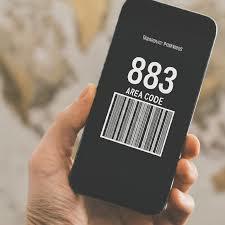The three-digit sequence “area code 883” is one of the most confusing codes because it is neither a standard geographic area code in the United States or Canada, nor is it a country-specific code.
Instead, the +883 code is an International Shared Country Code assigned by the International Telecommunication Union (ITU) for use by non-geographic networks. These numbers are generally used for global Voice over IP (VoIP) services, machine-to-machine (M2M) communications, and other mobile or data networks that are not confined to a single country.
If you encounter a number starting with +883, it is a legitimate international number, but it is not linked to any physical country or time zone.

-
The True Identity: +883 International Networks
The official designation for the +883 code is International Networks. It is part of the global numbering scheme (along with +882) designed to provide unique numbering space for services that transcend national borders.
| Feature | Detail |
| Code Type | International Shared Country Code (ITU-T E.164) |
| Location | Non-Geographic (Not tied to any country/city) |
| Purpose | Global VoIP services, Machine-to-Machine (M2M) communications, and specialized networks. |
| Example Service | Formerly used by the iNum initiative (a global phone number service). |
Numbering Structure
Unlike a regular phone number, which is +Country Code (Area Code) Local Number, a +883 number includes a mandatory Service Provider Identification Code (SPIC) after the +883 prefix.
The SPIC (which can be 3 or 4 digits long) identifies the specific global carrier or service that issued the number. Therefore, a full number looks much longer than a typical phone number, often consisting of 15 digits in total (including the +883 code).
-
Status in the U.S. and North America
The sequence 883 is not a valid geographic area code within the North American Numbering Plan (NANP).
- NANP Status: In the U.S. and Canada, geographic area codes (NPAs) cannot begin with 0 or 1. Furthermore, 883 is listed as unassigned for geographic use.
- Phone Exchange (NXX): The number sequence 883 can appear as the middle three digits (the prefix/exchange) of a local U.S. number, such as (805) 883-XXXX in the Santa Barbara, CA, area. This is a normal, local assignment and is unrelated to the +883 international code.
-
Dialing and High-Cost Warning
If you need to call a number beginning with +883, be extremely cautious of the potential cost.
- Extremely High Rates: Calls to +883 numbers are often treated as premium international calls by traditional phone carriers. Rates can be highly variable and may range from $0.60 to over $4.50 per minute.
- Check Your Carrier: Before attempting to dial an +883 number, check your carrier’s current price list specifically for the +883 code and the carrier’s SPIC (the digits immediately following 883).
How to Dial an +883 Number
- Dial the International Exit Code (011): (Or use the + symbol on a mobile phone).
- Dial the Shared Country Code (883).
- Dial the full remaining number (including the Service Provider ID Code).
Example: Calling an EMnify number (+883 03 XXXXXXXXX) from the U.S.:
Frequently Asked Questions (FAQ)
Is 883 a toll-free number?
No. The +883 code is the opposite of a toll-free number. U.S. and Canadian toll-free numbers start with 800, 833, 844, 855, 866, 877, or 888 and are free for the caller. The +883 code is an international code that is usually very expensive for the caller.
Is the +883 code used by satellite phones?
The +883 code is one of the codes reserved for global communications, which can include satellite, VoIP, and other specialized mobile networks. Its sister code, +882, is more commonly associated with certain mobile satellite services (MSS) and global mobile networks.
What is the time zone for an 883 number?
There is no specific time zone. Since the +883 code is non-geographic, the number could be answered by a service located anywhere in the world. You must contact the service directly (often via email or website) to determine its operational hours.


